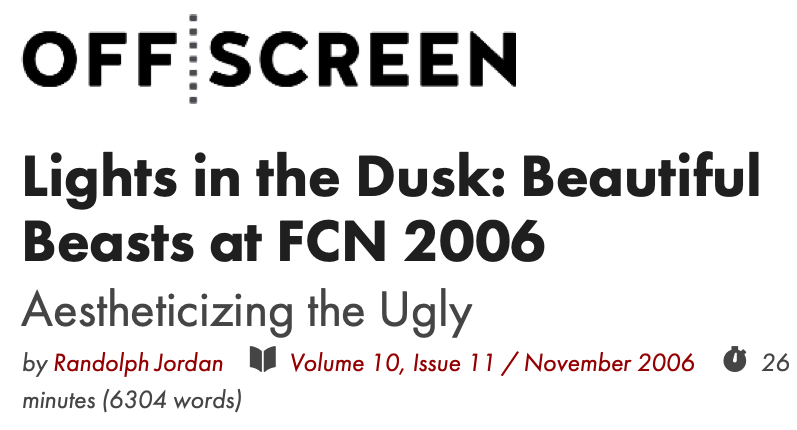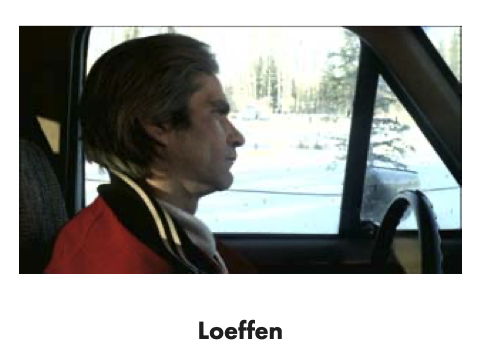
Hakan Sahin’s Snow is the only film that I selected purely on the basis of its description in the newsprint version of the catalogue: “A man and his dog are lost in the snow at an oilfield in Northern Alberta. Beautiful, simple, and poetic.” I never expect a film’s blurb to match what the film itself offers, but in this case the description really led me astray. The film is indeed about a man, Loeffen, and his dog Blackie, but whether or not he’s lost in the snow is wide open to interpretation. I was waiting the whole film for him to get definitively lost as he drove to and from his job at the oilfield, stopping each time in the town of Zama to take meals at the local greasy spoon where he has taken a liking to a cute waitress. Now that the film is done I’m still not sure if Loeffen ever really did lose his way. At first it all seemed a bit hokey to me. Here’s a guy driving his pick-up in a winged winter hat wearing a hoodie and bright orange jacket, talking to his dog in stilted, hoser lingo reminiscent of the McKenzie Brothers. Slowly, however, Loeffen grew on me – just about as slowly as the structure revealed itself to be decidedly non-linear. The film opens with Loeffen swerving into a ditch to avoid hitting something he’s not sure he saw, and then successfully backing out of the ditch with the help of his truck’s four- wheel drive setting. This scenario then recurs at several points throughout the film, and is slightly different each time until, finally, he is not able to get the truck out of the ditch. Between these recurrences we find Loeffen hitting on his favourite waitress, visiting another woman at her work (and being clearly rejected in so doing), and attending the winter solstice party where he tries to get to know a couple of young women above the noise of the blaring music.
Are we to understand these events as separate occurrences upon several trips to Zama, each trip finding him stuck in a ditch along the way? Or are these the events of a single day, broken up by imagined scenarios on the road into town? Or is he really just stuck in a ditch and imagining the whole thing? No answer is given. What the film does provide, however, is an ultimately heart-wrenching portrait of a lonely man, unaccepted by the world in which he lives, searching desperately to connect with someone but not really knowing how that is done. Showing up unannounced to bother a woman you barely know at work is not a good strategy. As for the waitress, we are initially led to believe that she might be feeling similarly harassed by Loeffen’s attention. Yet we discover later that she is rather unhappily married, and has actually been enjoying Loeffen’s visits as relief from her own stagnant domestic situation. Loeffen’s efforts at the solstice party seem initially to be in vain; at one point his conversation with one of the girls is rudely usurped by the appearance of a much younger and hipper boy who clearly has designs on the girl himself. The situation seems hopeless. And then, all of a sudden, we cut to Loeffen and two girls heading to one of their apartments and sharing a joint and some conversation for an extended period of time. If they weren’t interested in him, why would they possibly invite this old guy back to their pad, with the younger suitor now nowhere to be found? Later we cut to Loeffen driving home after his evening out, and it is clear that he did not stay the night with the two girls. But what are we to make of this encounter? Loeffen is convinced that one of the girls really liked him, and he tells his dog about his plans aloud to return and ask her out soon. We are left wondering if he’s delusional, or if there really was some chemistry going on earlier that evening.

This is so often the question between people who have met each other for the first time, and the film frames the reality of such basic social awkwardness around the potential antisocial perspective that Loeffen has on the world. And it does so in a very subtle manner. Loeffen never seems dangerous, yet clearly there is something not quite right about how he finds his way through his environment. The film concludes with him finally unable to pull himself out of the ditch, and wandering with his dog into the wilderness where he finds a small cabin in which to take refuge. I wouldn’t say he’s lost at this point, but he’s certainly not where he wants to be. And yet this is the most comfortable he’s ever been in the film so far. The cabin’s owner finds him there, and they share a meal, a drink, and some conversation. The man has been living in this cabin since his son went missing in the area while camping some years before. His experience is framed by loss, and the need to reconnect to the world by living at the source of this loss. In an alternate reality Loeffen could be this man’s son, finally returned home after wandering aimlessly for so long. Effectively this is how this scene feels, a moment of peace for Loeffen in a world he really isn’t able to connect to. As morning arrives, he ventures back out into the snow, and finds a reflection of himself there which suggests that he may have finally come to terms with an aspect of his being that has remained indistinct throughout his life. Or he may finally be lost, unable to see what lay ahead, looking outward into the world but seeing only that which lies behind him. While the film is splendidly shot, the film’s quality rests on Loeffen, a man whose general demeanor seems anything but beautiful, but whose relationship to the world points to a longing for beauty that shines back upon him in the form of the inaccessible. Sahin handles this material with grace, and this film, his second, suggests great things to come.

